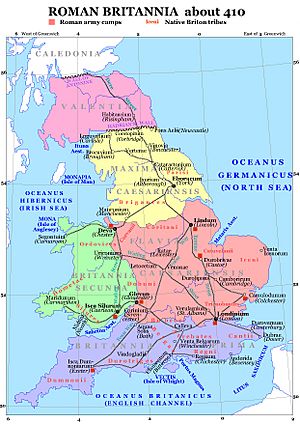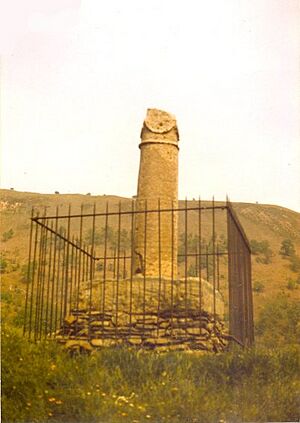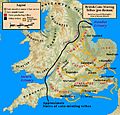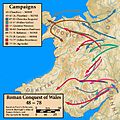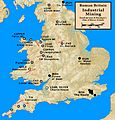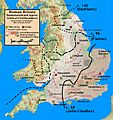Roman Wales facts for kids
Roman Wales is the name for the part of modern-day Wales that was controlled by the mighty Roman Empire. The Romans ruled this area from the 1st century AD until the 5th century AD. They saw it as part of their larger province called "Roman Britannia."
Contents
Life in Roman Wales
Roman Wales was a region in the southwest of Roman Britain. The Romans controlled it for about 400 years. By the early 5th century, southeast Wales was fully under Roman influence.
Who Lived in Wales Before the Romans?
Before the Romans arrived, people in Britain spoke "Brythonic" languages. These were part of the Celtic languages family. The people were known as Britons. Modern Wales was home to several tribes. The two biggest and strongest were the Silures in the southeast and the Ordovices in central and northwest Wales. These tribes fought hard against the Roman invasion.
The Roman Invasion of Wales
The Romans first attacked the Celtic tribes in Wales around 48 AD. This was led by a Roman general named Publius Ostorius Scapula. He first went after the Deceangli tribe in the northeast. They gave up without much of a fight.
Then, Ostorius spent several years fighting the Silures and the Ordovices. Their leader was a brave warrior named Caratacus. He had run away from southeast England when the Romans conquered it. Caratacus first led the Silures. Later, he moved to the Ordovices' land. There, Ostorius defeated him in 51 AD. Caratacus fled to the Brigantes tribe. But their queen handed him over to the Romans.
Fighting Back Against Rome
The Romans divided their new province Britannia into a civilian lowland zone and a highland military zone. Fortresses, each capable of housing a legion of 5,600 men, were established at York, Chester and Caerleon. In Wales, part of the military zone, there were at least 30 auxiliary forts linked by straight roads and situated a day's march from each other.The forts were not all fully manned for long, as most of the inhabitants of Wales came to accept Roman rule.
The Silures tribe fought very well against the Roman army. General Ostorius died while this tribe was still free. After his death, the Silures even won a battle against the Roman Second Augusta Legion.
The Romans did not try to expand their control in Wales for a while. Then, another general, Caius Suetonius Paulinus, took charge. He attacked further north and captured the island of Anglesey in 60 or 61 AD. However, he had to stop his attack. A major rebellion led by Boudica forced him to return.
The Silures finally came under Roman rule. This happened after a series of campaigns led by Sextus Julius Frontinus. These campaigns ended around 78 AD. His replacement, Gnaeus Julius Agricola, defeated the Ordovices. He also recaptured Anglesey by early 78 AD.
Roman Life and Changes in Wales
Wales was part of the Roman Empire for over 300 years. During that era Roman habits and culture won widespread acceptance in much of the country. Yet, unlike in most of Western Europe, the Latin of the Romans did not replace the native language of the people. It did, however, have an impact upon it, for Brythonic absorbed Latin words for things like forts, windows, rooms and books, words which were passed on to Welsh.Roman art had an impact too, for it replaced the Celtic art of the Britons. Among members of the upper classes at least, there was a readiness to accept that they themselves were Roman, especially after AD 214 when the emperor, Caracalla, granted Roman citizenship to all free men throughout the Empire.
The Romans controlled all of what is now Wales. They built many Roman roads and Roman forts. They even mined gold at a place called Luentinum. They also traded goods. However, the Romans were not super interested in Wales. This was because of its tough mountains and not much flat land for farming. Most of the Roman remains found in Wales are military buildings.
The Roman army controlled the area from large bases. These were at Deva Victrix (modern Chester) and Isca Augusta (modern Caerleon). These were two of the three main Roman army bases in Britain. Roads connected these big bases to smaller Roman forts. Examples include Segontium (now Caernarfon) and Moridunum (now Carmarthen).
The Romans are known to have built only one town in Wales. This was Venta Silurum (now Caerwent) in Monmouthshire. The fort at Moridunum (Carmarthen) later grew into a civilian settlement. Modern Wales was likely part of a Roman province called "Britannia Superior." Later, it became part of "Britannia Secunda." This province also included parts of what is now western England.
Protecting the Coast
In the late 3rd century, a new problem arose. Pirates from Hibernia (modern Ireland) started attacking the coast. To stop them, the Romans built a special fort at Cardiff. They also improved other defenses.
It's not clear when the Roman army left the base at Caerleon for good. It might have been by the end of the 3rd century. Some soldiers might have stayed there until the mid-4th century.
By the late 4th century, Roman military posts in Wales were at Cardiff, Caernarfon, Holyhead, and Caerhun. These were likely there to stop ongoing attacks by Irish groups.
The remaining military posts seem to have been left around 393 AD. Soldiers were needed to fight a rebellion in Gaul (modern France). There is some evidence that troops might have stayed to guard the towns of Carmarthen and Caerwent into the 5th century.
The End of Roman Rule in Wales
The Romans ruled Wales from the 1st century AD. They left Britain almost 400 years later. After they left, the province changed into "Sub-Roman Britain." This is when Wales as we know it began to appear in the Early Middle Ages.
South-east Wales was the most Romanised part of the country. It is possible that Roman estates in the area survived as recognisable units into the eighth century. The kingdom of Gwent is likely to have been founded by direct descendants of the (romanised) Silurian ruling class.
The only city the Romans founded in Wales was Caerwent. It was called Venta Silurum when it was created in 75 AD. It was also the last place the Romans left.
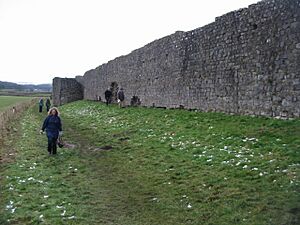
The town did not have strong defenses until the mid-4th century. That's when stone town walls were built. A small group of soldiers might have been based there then. Large parts of these defensive walls are still standing. Some are as tall as 5 meters (17 feet).
These walls have been called "easily the most impressive town defense to survive from Roman Britain." They are also "one of the most perfectly preserved in Northern Europe" because they haven't been rebuilt much.
The Roman town stayed busy even after the Roman soldiers left. People lived there until at least the end of the 5th century. Some people even think Caerwent might have been Camelot, the legendary home of King Arthur. This is because it's only ten miles from the Roman fort Isca Silurum (now Caerleon). Geoffrey of Monmouth wrote that Caerleon was where the Round Table was located.
Also, it seems that Christian worship was already happening in Caerwent in the 5th century. The town might even have had a bishop. A monastery was started by Saint Tatheus in the 6th century. A Christian cemetery was also set up near where the church is today.
The name Venta gave its name to the new Kingdom of Gwent. The town itself became known as Caer-went, meaning "Fort of Venta/Gwent." Stories say that Caradog Freichfras of Gwent moved his court from Caerwent to Portskewett in the second half of the 6th century. This marked the end of the last Roman influence in Wales.
Historian Gwyn A. Williams suggests that even when Offa's Dyke was built, people west of it still saw themselves as "Roman." This is because Latin writings were still being made into the 8th century.
Related pages
Images for kids
-
Aerial view of the amphitheatre at Caerleon.


